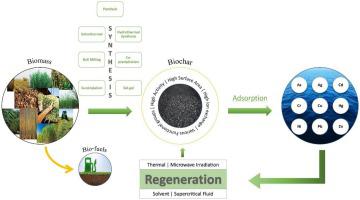Journal of Water Process Engineering ( IF 6.3 ) Pub Date : 2020-10-18 , DOI: 10.1016/j.jwpe.2020.101561 Sarthak Gupta , S. Sireesha , I. Sreedhar , Chetan M. Patel , K.L. Anitha

|
Biochar, a solid carbon-rich residue is derived from wide variety of abundantly available raw materials like forest and agricultural waste, industrial by products and waste, and municipal solid waste through pyrolysis. Besides enhancing soil fertility thereby agricultural productivity and reducing greenhouse gas emissions, biochar based sorbents are widely being employed in waste water treatment owing to their attributes viz., high porosity, large surface area, affinity towards metals, surface modifications, stability, recyclability and even safe disposal. In this comprehensive review, latest trends w.r.t. synthesis protocols, modifications, mechanisms, metal removal comparison, thermo-kinetics, mechanisms, regeneration and safe disposal methods have been presented and discussed. Synthesis through slow pyrolysis (300−700 °C, 0.01−2 °C/s), nanoscale modifications with metal oxides especially based on iron to magnetise the biochar, regeneration through acids and complexation agents are found to be highly promising. While ion exchange and electrostatic interactions are found to be common mechanisms of metal removal which in turn depends on nature of biomass, process conditions and metal, it is found that modifications and mechanisms are strongly interrelated. From our studies, biochar based sorbents gave heavy metal adsorption capacities in mg/g of 1217 (Ag), 560 (Pb), 288 (Cu), 216 (Cd), 204 (As), 130 (Cr), 58 (Ni), 48 (Hg) etc under optimal conditions. Though the nature of kinetic models and isotherms do depend on the material and process conditions, pseudo kinetic models (first and second order) along with Langmuir and Fruendlich isotherms were most widely reported. Disposal of spent biochar could be using it in construction (cement and bricks) and electronic (super-capacitors) industries besides phytoremediation.
中文翻译:

生物炭基吸附剂去除废水中重金属的最新趋势
生物碳是一种富含碳的固体残渣,其来源广泛,包括森林和农业废料,工业副产品和废料以及热解产生的城市固体废料等大量可用原料。除了提高土壤肥力,从而提高农业生产力和减少温室气体排放外,基于生物炭的吸附剂还因其具有以下特性而广泛用于废水处理:高孔隙率,大表面积,对金属的亲和力,表面改性,稳定性,可回收性甚至安全处置。在这份全面的综述中,已经提出并讨论了合成方案,修饰,机理,金属去除比较,热动力学,机理,再生和安全处置方法的最新趋势。通过慢速热解(300-700°C,0.01-2°C / s)进行合成,已发现用金属氧化物(尤其是基于铁的金属氧化物)进行纳米级修饰以磁化生物炭,通过酸和络合剂进行再生非常有前途。尽管发现离子交换和静电相互作用是金属去除的常见机理,而金属去除又取决于生物质的性质,工艺条件和金属,但发现修饰和机理之间有着密切的联系。根据我们的研究,基于生物炭的吸附剂以mg / g计的重金属吸附能力为1217(Ag),560(Pb),288(Cu),216(Cd),204(As),130(Cr),58(Ni) ),48(Hg)等在最佳条件下。尽管动力学模型和等温线的性质确实取决于材料和工艺条件,但伪动力学模型(一阶和二阶)以及Langmuir和Fruendlich等温线的报道最为广泛。











































 京公网安备 11010802027423号
京公网安备 11010802027423号